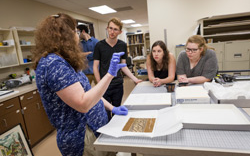Why do people argue the cultural significance of the Parthenon, a former Greek temple? Why are women underrepresented in computer science and mathematics? What effect do the thousands of widely used chemicals have on human and environmental health?
Willamette students and faculty members are exploring these and other questions through the Liberal Arts Research Collaborative (LARC 2.0), a nine-week program offered each summer at Willamette University.
By creating summer research communities and promoting curricular innovation, LARC aims to give undergraduates a wide breadth and depth of research-rich academic experiences.
Through the program, professors in the humanities and social sciences hire select undergraduates to engage in collaborative research projects. Come fall, the students will give presentations and share papers on their findings.
“There is nothing quite like this offered in the classroom,” says Karen Page ’16, a classical studies and art history double major. “I’m definitely looking at this as thesis practice.”
Demystifying the Parthenon
Page is one of five students working with art history professor Ann Nicgorski and rhetoric professor Jeanne Clark, who are team teaching a new course this fall about the Parthenon.
In conjunction with the class, Nicgorski is organizing a speaker series and exhibition at the Hallie Ford Museum of the Art — both about the Parthenon. The students are providing feedback on assigned texts for the course and are working on their own, related research projects.
“This gives our students an opportunity to grow as scholars,” Clark says. “They’re exploring areas that intrigue them.”
Nicgorski and Clark are investigating the Parthenon’s significance in the ancient world. Constructed from 447 to 438 BC, the former temple is dedicated to the goddess Athena and is regarded as one of the world’s greatest cultural monuments.
Fascinated by the building and its history, Page and Luc Marceau ’18 say they’re learning how to locate and synthesize an overwhelming amount of information through their research projects. When complete, they expect to share their findings through 30-page papers.
“I’ve never done a self-guided project of this scale before,” Page says. “But this is a really supportive environment. I’m starting to feel comfortable thinking for myself and deciding where I want to take my project.”
Nicgorski enjoys watching her students gain confidence in their newfound skills.
“They learn to work independently a bit earlier and more effectively than other students,” she says. “This will help them prepare for their senior projects.”
Understanding Occupational Segregation
In another LARC project, four students are helping economics professor Tabitha Knight and computer science professor Haiyan Cheng research the underrepresentation of women in STEM fields (science, technology engineering and mathematics).
Specifically, they’re investigating how the IT industry treats women in terms of wages, benefits, professional development and promotion opportunities. They’re exploring IT companies’ codes of ethics, as well as comparing the occupational segregation in STEM fields to other industries in America.
For Knight and Cheng, LARC enables them to look at the same issue through a different lens.
“We can learn from each other and from our students,” Cheng says.
Knight agrees, adding that she hopes the team will publish a few papers in established academic journals.
“Getting published would be wonderful for the students’ resumes,” she says. “It would show that they have superior writing and analysis skills. It would also prove that they can do this type of work and that they can finish what they start.”
Juliette Hallberg ’17 has a vested interest in the research findings. Although a computer science major, she had no exposure to the field until she enrolled at Willamette. And even in her STEM classes here, men outnumber women five to one.
“I really think women don’t know what computer science is or what it does,” she says. “I want to understand why.”
Environmental Health Questions
In the final LARC project, five students are working with anthropology professor Joyce Millen and biology professor Barbara Stebbins-Boaz to address environmental health issues and concerns in the greater Willamette Valley.
“More than 80,000 chemicals available in the United States have never been fully tested for their toxic effects on our health and environment,” Millen says.
“Environmental health concerns the air we breathe, the water we drink, the soil upon which we grow crops, the food we consume and the products we use on our bodies and in our homes. It is both a discipline and a social movement.”
Each student — representing such majors as anthropology, history, biochemistry and economics — is conducting independent research about specific environmental health topics.
Their wide-ranging research topics focus on elevated bone cancer rates in West Salem; harmful industrial chemicals used to line cans and other food storage containers; attempts to regulate diesel fuel emissions in Oregon; children’s exposure to toxins in day-care centers; and efforts to help dry cleaners become more aware of safer and more environmentally friendly solvents.
As part of their projects, the students interviewed environmental health experts. They also visited and toured several agencies and laboratories in Oregon, including the Department of Environmental Quality, Oregon Health and Science University and the Oregon Environmental Council.
The students’ research findings will serve the agencies with which they are collaborating. Plus, they will form the basis of a new set of environmental health curricular offerings Millen and Stebbins-Boaz will bring to Willamette.
For more information about the LARC program, go to the LARC landing page.

